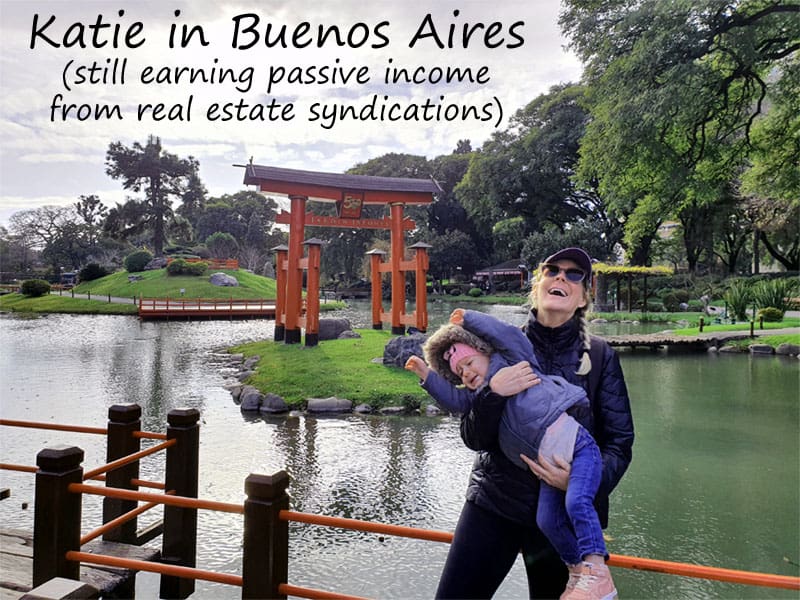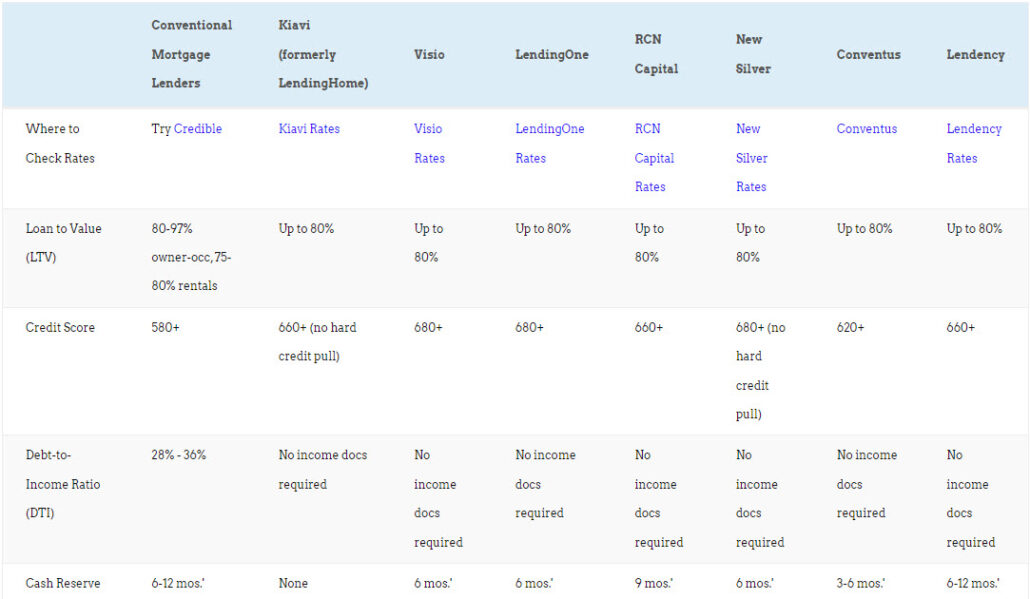
With inflation soaring at levels not seen since 1981, everyone wants to invest in assets that protect against inflation.
Assets like, say, real estate.
But real estate is expensive, costing hundreds of thousands for a single rental property. You can take out an investment property loan of course, but you still need to come up with a 15-30% down payment.
Which begs the question: What are some creative financing strategies to cover the down payment too?
Creative Financing for Investment Properties
If you’re new to financing investment properties, start with the standard options: traditional mortgages and portfolio loans.
Traditional mortgage lenders pick a Fannie Mae or Freddie Mac loan program for you, and then bundle and sell your loan right after you settle. They’re cheaper than most options, but they only let you have a few loans reporting on your credit before they stop lending to you. That usually means a maximum of four mortgages total, including your home mortgage. Four loans won’t take you far as a real estate investor.
Portfolio lenders keep their loans on their own books — within their own portfolio — rather than selling them off. That makes them far more flexible; in fact, many portfolio lenders also lend hard money loans for buying and renovating properties. They don’t report to the credit bureaus, and they don’t limit how many loans you can have. Try Forman Loans, Visio, or Kiavi as strong options.
But that still leaves you to come up with a down payment.
Try these creative financing ideas, as you explore ways to minimize your down payment on a rental property.
1. Owner Financing
In investing as in life, you don’t get what you deserve; you get what you negotiate. So as you make offers, feel out the seller on whether they’re open to owner financing.
That could come in the form of a seller-held second mortgage. Or, if you can’t get financing for an investment property through a conventional lender or portfolio lender, you can try negotiating seller financing for your primary loan. Anxious or motivated sellers may consider financing your deal themselves in order to settle fast.
You and the seller can negotiate everything from the loan term to interest rates and beyond. Usually, seller financing involves a balloon: you have to refinance the loan within a few years, to pay off your remaining balance in full. That gives you time to build your credit, and the property time to appreciate in value.
Downsides: The only downside to owner financing is that it’s not a reliable source of funding for investment properties. The seller must agree to it, and some sellers refuse to consider it.
Still, many do, especially if it means a quick settlement. Push that angle as you negotiate with sellers, and consider combining business credit lines (more on them shortly) with seller financing so the seller gets to walk away from the table with a hefty paycheck even if they finance the rest.
2. Assume the Seller’s Loan
When interest rates are high, it’s extra enticing to take over the seller’s mortgage loan rather than borrowing your own.
You get a low-interest loan, further along in its amortization schedule. That means more of each monthly payment goes toward principal rather than interest, and you enjoy low monthly payments with a relatively short remaining loan term.
Of course, it also leaves the seller vulnerable to you defaulting on a loan in their name. Some sellers approach this with a variation on owner financing called a wrap-around mortgage. You sign a promissory note for seller financing, and they keep their existing loan in place while they come out of pocket to finance the rest of your loan. They earn a relatively high interest rate on the portion of the loan they funded, and you still get a deal on financing.
Downsides: Most sellers don’t understand how wrap-around mortgages work. You’ll need to wrap your own head around them before you explain and pitch them to a seller.
The greatest risk with wrap-around mortgages is that lenders typically include a “due on sale” clause in their loan documents. If the ownership transfers, the loan becomes due in full. That leaves you and the seller crossing your fingers that the lender doesn’t find out they transferred the deed to you.
Unless, that is, you buy through an installment contract.
3. Installment Contracts
Also known as a contract for deed, installment purchase contract, installment land contract, or bond for deed, installment contracts work similarly to owner financing, except the seller keeps legal ownership until you’ve paid off the balance in full.
Deni and I use installment contracts in our land investing business. We offer parcels of land for sale in two ways: a traditional purchase price, or a slightly higher total amount financed over several years.
Contracts for deed can either be amortized like a mortgage loan, can involve a set margin over the cash price which is then just divided by the number of months of installment payments, or they can feature a balloon payment. Again, all terms are negotiable with the seller.
If you go this route as a buyer, make sure you record the contract for deed among your local land records, so you can enforce the contract if the seller tries to pull out or otherwise misbehaves.
Alternatively, you could sign a lease-option agreement with the ability to sublet. You lock in a future purchase price, and you can rent it out to start collecting revenue now. Many investors use this strategy for Airbnb arbitrage, where they sign a long-term lease agreement and then rent the property out short-term on Airbnb.
Downsides: Installment contracts come with risk, since you don’t actually take title to the property. The seller could fail to pay the property taxes, and the property could end up in tax sale. Or they could try to renege on recording the deed, after you pay off the balance in full. Or, if you fall behind on payments, the seller may not have to foreclose on you to reclaim possession — in some states, they can simply file for eviction.
4. Business Credit Lines & Cards
The beautiful thing about most business credit lines and business credit cards is that they are unsecured: they don’t attach a lien against your home or rental properties.
And yes, real estate investors qualify for them. Real estate investors are entrepreneurs, after all!
Creditors typically set limits on your business credit lines and credit cards based on your personal credit score, your income and revenue, and your business credit (if established). We work closely with Fund&Grow to help real estate investors get business credit lines totaling between $50-250K, with the average investor getting $150-200K in total credit lines and cards. They also show you how to use credit cards to fund real estate transactions without paying a cash advance fee.
You can use these rotating credit lines for down payments, renovation costs, or to buy properties outright. From there, you can pay them back on your time, however quickly or slowly you prefer.
Once you have the credit lines, you can keep using them repeatedly, forever. That makes them an excellent ongoing source of funds for deals.
And hey, you might even rack up some credit card reward points!
Downsides: While you could probably get one or two unsecured business credit lines on your own, most real estate investors need help with these. They need help negotiating higher credit limits, scrubbing the credit pulls from their credit reports, and going through multiple rounds of account opens. See this webinar we held recently on how the process works.
5. Home Equity Loan or HELOC
One of the most common ways to finance a down payment on an investment property is to take out a home equity loan. A home equity loan is essentially a loan that is funded by your current investment in your home — you use the equity in your home as the funding source for a new down payment or entire loan.
A home equity loan is a mortgage you take out against your current home. It could be a second mortgage, if you already have one mortgage in place. Or it could be a first mortgage, if you own your property free and clear. Like all mortgages, you can take out home equity loans at a fixed interest rate.
Alternatively, a home equity line of credit or HELOC is a rotating credit line. You can draw on it as needed for uses like buying investment properties, usually at a variable interest rate during the draw phase. After a certain number of years, the HELOC switches over to the repayment phase, when it converts to a fixed loan that you make regular payments against like a mortgage.
Bear in mind that you can take out both home equity loans and HELOCs against rental properties as well, not just your primary residence.
Home equity loans and HELOCs work well for investors who do not have much liquid cash on hand, but have money tied up in real estate, such as a home or perhaps a vacation rental. They make real estate investing a more achievable dream for current homeowners.
Downsides: A home equity loan is secured by assets such as your home, which makes it great for finding a funding solution, but you risk losing your home if you’re unable to repay the bank. In addition, if you currently have a property that you are just needing cash to renovate and fix-up, a home equity loan may not be necessary while a personal loan or unsecured business line of credit could meet your needs.
6. Cross Collateralization
If you have equity in another property, you can put it up as additional collateral when you apply for an investment property loan. The lender takes first lien position on the new property you’re buying, and second lien position on your existing property.
In exchange, they lend you 100% of the purchase price, so you don’t have to come up with a down payment.
Imagine you have a property worth $250,000, and you only owe $100,000 against it. Sure, you could take out a second mortgage or a HELOC against it to tap into that equity, but you’d have to pay for a new round of closing costs.
Instead, when you find a new property you like, you approach a lender like Forman Loans or New silver and say “Rather than a 20% down payment, I can give you a second property as additional collateral on the loan.” They get two properties as collateral to protect them, and you get 100% financing.
Downsides: First, you have to have significant equity in an existing property. Not everyone does.
But you also add to your risk. If you default on the loan, you risk losing not just the main property, but also another unrelated property of yours.
7. Personal Loans
Personal loans are a great option if you need funding quickly. Many personal loan companies can provide funding as quickly as the next business day to those who qualify. You can typically use your personal loan for whatever you like, which means that you can consider it as an option to help you invest in real estate or make renovations on a current investment.
With a personal loan, you can expect a traditional lending agreement. The lender sets the loan limit, interest rate, and fees, and you sometimes get a few options on the loan term. Your credit history matters, so work on improving your credit if you want the best rates and terms.
Downsides: Personal loans typically only lend, on average, up to $50,000 max. A few personal loan companies lend closer to $100,000, but for many real estate investors that still doesn’t cover their purchase price or even down payment.
Also, personal loans are notorious for high interest rates compared to a traditional home loan: the average personal loan rate is around 10%. That can leave you with a high monthly payment on top of your mortgage payment. If a personal loan seems like it could be the right direction for you then compare personal loan companies here.
8. Invest with a Self-Directed IRA
Have some funds in your IRA, that you’d rather use to invest in real estate?
You can create a self-directed IRA to use for tax-free real estate investing. It diversifies your investment portfolio while giving you even more tax advantages beyond rental property tax deductions and ways to avoid capital gains tax on real estate.
Many people start contributing to IRAs when they first enter the workforce, making this a great option for those far enough along in their career to have contributed significantly to their IRA fund. Check out this case study on investing in rental properties with a self-directed IRA.
Downsides: Dipping into your IRA does come with complexities. The tax and legal red tape that can make the process confusing, and you’ll need to hire an SDIRA custodian. If you only have enough in your IRA to cover the down payment, you only get tax advantages proportional to the amount you invested from your IRA rather than through financing.
Bear in mind that all ongoing expenses must also come out of your IRA, no other funding sources. Make sure you have enough funds in your IRA to comfortably invest.
9. Borrow Against Your 401(k)
Have a 401(k) through your job?
While you can’t use it to invest in real estate, you can borrow against it. As a general rule, you can borrow up to 50% of your 401(k) balance, up to a maximum of $50,000.
You can use that loan for a down payment on a rental property, or for renovation costs on a flip or BRRRR deal. Or, for that matter, for anything else, such as a direct mail campaign.
These loans typically come with low interest rates, since they’re secured by your 401(k) account with a low loan-to-value ratio (LTV).
Downsides: If you screw up, you risk your nest egg. ‘Nuff said.
Beyond the risk to your financial future, 401(k) loans do charge interest and come with fees. Also, not all 401(k) administrators allow loans, so you may not have the option even if you have a hearty 401(k) balance.
10. Gap Funding
Some lenders offer to cover your down payment on an investment property — for a steep price.
That price could come in the form of sky-high interest and fees. Or they may require a piece of the action, in the form of an ownership share in your real estate deal.
Why do these loans cost so much? Because they come with extremely high risk for the lender. They not only take a second lien position behind your main investment property loan, but they’re also lending you the entire down payment. That leaves you with no skin in the game.
As the saying goes, a piece of something is better than all of nothing. If you don’t have enough money to close a good deal, gap lenders can cover your shortfall to let you do so. You won’t earn as much as you would have otherwise, but that’s the cost of not having the cash needed for the deal.
Check out Tony Javier as an example of a gap lender.
Downsides: Expect high interest rates and lender fees, or a partial stake in the deal.
11. Economic Development Grants
Government funding is an option if you are looking to invest in lower-income real estate. Select government programs are looking to offer grants to real estate investors, hoping that the construction of a new home can bring more employment opportunities in that community.
Besides a grant, the Economic Development Association (EDA) will help provide other technical assistance if an investor meets certain criteria. The hope is that real estate investors and communities will benefit from the government intervention.
Downsides: This option can work well for investors in a lower income community, however you must apply for a grant which can take several weeks to review and the grant is not guaranteed to everyone that applies. Grants also don’t finance all or even the majority of the property – you still have to come up with most of the money yourself, in most cases. Make sure to look at all the details of a government grant before you rely on this option as a source of funding.
12. Private Notes
Private money lenders are individuals, not banks, that loan out money to real estate investors. In most cases, they are people you know: friends, family members, acquaintances, and others who feel confident enough in your track record to fork over their hard-earned money.
Because the money comes from individuals, rather than institutions, it comes fast. Theoretically, friends and family members could send you money on the same day you request it!
You can also negotiate your own terms with private lenders, and typically pay lower fees than corporate lenders charge. That frees up more capital to pour into your actual investments, and raises your cash-on-cash returns.
You may generally pay high interest rates on these private promissory notes however, which affect your monthly costs when you calculate rental cash flow.
Downsides: New investors can’t raise private loans, because they have no track record. It’s not only difficult to ask friends and family for money if you don’t have much real estate investing experience, but it’s irresponsible. New real estate investors make mistakes, sometimes costly ones, and you need to earn the right to raise money privately from friends and family.
13. Bring on Capital Partners
If you have expertise in real estate investing but you’re strapped for cash at the moment, you can always bring on a silent partner to provide the capital.
Say a deal comes across your desk that you like, but all your money is tied up in other projects. So you call up your friend Wendy and explain the deal, and offer to split the profits if she provides the cash. You arrange an investment property loan to cover 80% of the costs and oversee the renovations, she provides the 20% down payment, and you split the profits 50/50.
She gets to invest for truly passive income. You earn a return without having to invest a penny.
Downsides: To begin with, you need rich friends. Not everyone has them.
Additionally, you risk someone else’s money on the deal, which means you also risk your relationship with them if the deal turns sour. Imagine how awkward Thanksgiving will be if you blow $75,000 of your father-in-law’s money on a bad real estate investment!
Final Thoughts
I once bought and renovated a property with a credit card.
On the plus side, I didn’t have to use much of my own cash, racked up some credit card rewards, and paid no cash advance fees on the material costs. But I did pay cash advance fees for the rest — although you can reduce these by going through a service like Plastiq.
I also paid extremely high interest until I paid off the balance. Which took me about six months to do, putting every spare penny I had into it.
You have plenty of options for creative financing for real estate investment properties. Just beware that every one of them comes with a cost.
In particular, watch out for overleveraging yourself and ending up with negative cash flow. An investment that costs you money every month isn’t an asset — it’s a liability.♦
Have you ever used creative financing for investment properties? What creative financing strategies have you explored?
About the Author

Madison Smith is a personal and home finance expert at BestCompany.com. She works to help others make positive financial strides in their lives by providing expert insight on anything from credit card debt to home-buying tips.
























I totally agree with this Madison. I have been offering a lot of creative finance deals and sellers are loving it. I find even when they end up taking a cash offer, just the fact that they compared it helps them make a decision. I think I will be buying a lot more subject to and owner financing deals over the rest of 2020 (and beyond)
Glad to hear you’ve had success negotiating seller financing Steve!
I always prefer lending money from my friends and family members. But during this pandemic, I am thinking about some other alternatives.
There will definitely be some investing opportunities in the wake of the pandemic!
I’ve been tied up doing one deal at a time. But with some creative financing options, I could potentially do two or three deals simultaneously and really accelerate my real estate income. Thanks for the ideas!
Glad you found them helpful Sandra!
Creative financing still fascinates me. I primarily use my credit card then use other financing strategy such as a combination of investment property loans and private notes. It was nerve wracking at first but you get used to it.
Yeah you definitely get more comfortable with leverage as you get more experience investing in real estate!
Some interesting ideas here. I definitely need to expand my financing repertoire!
Glad to hear you got some fresh creative financing ideas out of it Archon!
Brian I have a question about working for equity can you email me at [email protected]
I have some big investing goals for next year, glad I bumped into this
Me too Sally!
I appreciate the insights, given me more ideas to explore financing options for my next property purchase.
Glad to hear it Heath!
I want to assume a mortgage from a seller that is in default. Do you have any recommendations for a lender who can finance the down payment required to take over the payments?
Hi Evelyn, it’s hard to get a mortgage for a rental property in second lien position. I think your best bet is unsecured business lines of credit through a service like Fund&Grow.